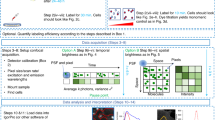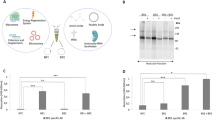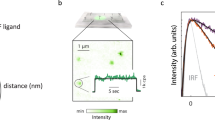Abstract
The formation of supramolecular structures (dimers or oligomers) is emerging as an important aspect of G-protein-coupled receptor (GPCR) biology. In some cases, GPCR oligomerization is a prerequisite for membrane targeting or function; in others, the relevance of the phenomenon is presently unknown. Although supramolecular structures of GPCRs were initially documented by classical biochemical techniques such as coimmunoprecipitation, many recent advances in the field of GPCR oligomerization have been prompted by the introduction of two new biophysical assays based on Förster's resonance energy transfer—fluorescence resonance energy transfer and bioluminescence resonance energy transfer. These modern techniques allow the study of protein–protein interaction in intact cells, and can be used to monitor monomer association and dissociation in vivo. Recently, oligomerization has also been reported in the case of the TSH receptor (TSHR). This review will focus on the previously unsuspected implications that oligomerization has in TSHR physiology and pathology. It is now clear that TSHR oligomerization is constitutive, occurs early during post-translational processing, and may be involved in membrane targeting and activation by the hormone or by stimulating antibodies. Oligomerization between inactive mutants and wild-type TSHR provides a molecular explanation for the dominant forms of TSH resistance.
Key Points
-
The formation of supramolecular structures (dimers or oligomers) is emerging as a relevant aspect of G-protein-coupled receptor biology
-
Fluorescence resonance energy transfer and bioluminescence resonance energy transfer are effective biophysical methods to monitor protein–protein interactions in vivo
-
The application of these methods allowed the demonstration that the TSH receptor (TSHR) exists as oligomers in living cells
-
TSHR oligomerization has relevant implications in physiology and pathology
-
Oligomerization between inactive mutants and wild-type TSHR provides a molecular explanation for the dominant forms of TSH resistance
This is a preview of subscription content, access via your institution
Access options
Subscribe to this journal
Receive 12 print issues and online access
$209.00 per year
only $17.42 per issue
Buy this article
- Purchase on Springer Link
- Instant access to full article PDF
Prices may be subject to local taxes which are calculated during checkout




Similar content being viewed by others
References
Terrillon S and Bouvier M (2004) Roles of G-protein-coupled receptor dimerization. EMBO Rep 5: 30–34
Milligan G (2004) G protein-coupled receptor dimerization: function and ligand pharmacology. Mol Pharmacol 66: 1–7
Park PS et al. (2004) Oligomerization of G protein-coupled receptors: past, present, and future. Biochemistry 43: 15643–15656
Rocheville M et al. (2000) Subtypes of the somatostatin receptor assemble as functional homo- and heterodimers. J Biol Chem 275: 7862–7869
Pfeiffer M et al. (2001) Homo- and heterodimerization of somatostatin receptor subtypes. Inactivation of SST(3) receptor function by heterodimerization with SST(2A). J Biol Chem 276: 14027–14036
Grant M et al. (2004) Agonist-dependent dissociation of human somatostatin receptor 2 dimers: a role in receptor trafficking. J Biol Chem 279: 36179–36183
Monnot C et al. (1996) Polar residues in the transmembrane domains of the Type 1 angiotensin II receptor are required for binding and coupling. J Biol Chem 271: 1507–1513
Abdalla S et al. (2004) Factor XIIIA transglutaminase crosslinks AT(1) receptor dimers of monocytes at the onset of atherosclerosis. Cell 119: 343–354
Miura S et al. (2005) Constitutively active homo-oligomeric angiotensin II type 2 receptor induces cell signaling independent of receptor conformation and ligand stimulation. J Biol Chem 280: 18237–18244
Terrillon S et al. (2003) Oxytocin and vasopressin V1a and V2 receptors form constitutive homo- and heterodimers during biosynthesis. Mol Endocrinol 17: 677–691
Zhu X and Wess J (1998) Truncated V2 vasopressin receptors as negative regulators of wild-type V2 receptor function. Biochemistry 37: 15773–15784
Kroeger KM et al. (2001) Constitutive and agonist-dependent homo-oligomerization of the thyrotropin-releasing hormone receptor. Detection in living cells using bioluminescence resonance energy transfer. J Biol Chem 276: 12736–12743
Song GJ et al. (2005) Regulated dimerization of the thyrotropin-releasing hormone receptor affects receptor trafficking but not signaling. Mol Endocrinol 19: 2859–2870
Latif R et al. (2001) Oligomerization of the human thyrotropin receptor: fluorescent protein-tagged hTSHR reveals post-translational complexes. J Biol Chem 276: 45217–45224
Latif R et al. (2002) Ligand-dependent inhibition of oligomerization at the human thyrotropin receptor. J Biol Chem 277: 45059–45067
Urizar E et al. (2005) Glycoprotein hormone receptors: link between receptor homodimerization and negative cooperativity. EMBO J 24: 1954–1964
Calebiro D et al. (2005) Intracellular entrapment of wild-type TSH receptor by oligomerization with mutants linked to dominant TSH resistance. Hum Mol Genet 14: 2991–3002
Roess DA et al. (2000) Luteinizing hormone receptors are self-associated in the plasma membrane. Endocrinology 141: 4518–4523
Horvat RD et al. (2001) Luteinizing hormone receptors are self-associated in slowly diffusing complexes during receptor desensitization. Mol Endocrinol 15: 534–542
Osuga Y et al. (1997) Co-expression of defective luteinizing hormone receptor fragments partially reconstitutes ligand-induced signal generation. J Biol Chem 272: 25006–25012
Ji I et al. (2002) Cis- and trans-activation of hormone receptors: the LH receptor. Mol Endocrinol 16: 1299–1308
Tao YX et al. (2004) Constitutive and agonist-dependent self-association of the cell surface human lutropin receptor. J Biol Chem 279: 5904–5914
Ji I et al. (2004) Trans-activation of mutant follicle-stimulating hormone receptors selectively generates only one of two hormone signals. Mol Endocrinol 18: 968–978
Fan QR et al. (2005) Structure of human follicle stimulating hormone in complex with its receptor. Nature 433: 269–277
Cornea A et al. (2001) Gonadotropin-releasing hormone receptor microaggregation. Rate monitored by fluorescence resonance energy transfer. J Biol Chem 276: 2153–2158
Horvat RD et al. (2001) Binding of agonist but not antagonist leads to fluorescence resonance energy transfer between intrinsically fluorescent gonadotropin-releasing hormone receptors. Mol Endocrinol 15: 695–703
Brothers SP et al. (2004) Human 'loss-of-function' GnRH receptor mutants retain wild type receptors in the endoplasmic reticulum: molecular basis of the dominant-negative effect. Mol Endocrinol 18: 1787–1797
Berglund MM et al. (2003) Neuropeptide Y Y4 receptor homodimers dissociate upon agonist stimulation. J Pharmacol Exp Ther 307: 1120–1126
Dinger MC et al. (2003) Homodimerization of neuropeptide Y receptors investigated by fluorescence resonance energy transfer in living cells. J Biol Chem 278: 10562–10571
Mandrika I et al. (2005) Melanocortin receptors form constitutive homo- and heterodimers. Biochem Biophys Res Commun 326: 349–354
Biebermann H et al. (2003) Autosomal-dominant mode of inheritance of a melanocortin-4 receptor mutation in a patient with severe early-onset obesity is due to a dominant-negative effect caused by receptor dimerization. Diabetes 52: 2984–2988
Bai M et al. (1998) Dimerization of the extracellular calcium-sensing receptor (CaR) on the cell surface of CaR-transfected HEK293 cells. J Biol Chem 273: 23605–23610
Bai M et al. (1999) Intermolecular interactions between dimeric calcium-sensing receptor monomers are important for its normal function. Proc Natl Acad Sci USA 96: 2834–2839
Jensen AA et al. (2002) Probing intermolecular protein-protein interactions in the calcium-sensing receptor homodimer using bioluminescence resonance energy transfer (BRET). Eur J Biochem 269: 5076–5087
Pin JP et al. (2005) Allosteric functioning of dimeric class C G-protein-coupled receptors. FEBS J 272: 2947–2955
Patel RC et al. (2002) Photobleaching fluorescence resonance energy transfer reveals ligand-induced oligomer formation of human somatostatin receptor subtypes. Methods 27: 340–348
Rocheville M et al. (2000) Receptors for dopamine and somatostatin: formation of hetero-oligomers with enhanced functional activity. Science 288: 154–157
Terrillon S et al. (2004) Heterodimerization of V1a and V2 vasopressin receptors determines the interaction with β-arrestin and their trafficking patterns. Proc Natl Acad Sci USA 101: 1548–1553
Hanyaloglu AC et al. (2002) Homo- and hetero-oligomerization of thyrotropin-releasing hormone (TRH) receptor subtypes. Differential regulation of beta-arrestins 1 and 2. J Biol Chem 277: 50422–50430
Saveanu A et al. (2002) Demonstration of enhanced potency of a chimeric somatostatin-dopamine molecule, BIM-23A387, in suppressing growth hormone and prolactin secretion from human pituitary somatotroph adenoma cells. J Clin Endocrinol Metab 87: 5545–5552
Milligan G and Bouvier M (2005) Methods to monitor the quaternary structure of G protein-coupled receptors. FEBS J 272: 2914–2925
Eidne KA et al. (2002) Applications of novel resonance energy transfer techniques to study dynamic hormone receptor interactions in living cells. Trends Endocrinol Metab 13: 415–421
Förster T (1948) Intermolecular energy migration and fluorescence. Ann Phys (Leipzig) 2: 55–75
Suhling K et al. (2005) Time-resolved fluorescence microscopy. Photochem Photobiol Sci 4: 13–22
Maurel D et al. (2004) Cell surface detection of membrane protein interaction with homogenous time-resolved fluorescence resonance energy transfer technology. Anal Biochem 329: 253–262
Xu Y et al. (1999) A bioluminescence resonance energy transfer (BRET) system: application to interacting circadian clock proteins. Proc Natl Acad Sci USA 96: 151–156
Ban T et al. (1992) Specific antibody to the thyrotropin receptor identifies multiple receptor forms in membranes of cells transfected with wild-type receptor complementary deoxyribonucleic acid: characterization of their relevance to receptor synthesis, processing, structure, and function. Endocrinology 131: 815–829
Grossman RF et al. (1995) Immunoprecipitation isolates multiple TSH receptor forms from human thyroid tissue. Thyroid 5: 101–105
Graves PN et al. (1996) Multimeric complex formation by the thyrotropin receptor in solubilized thyroid membranes. Endocrinology 137: 3915–3920
Alberti L et al. (2002) Germline mutations of TSH receptor gene as cause of nonautoimmune subclinical hypothyroidism. J Clin Endocrinol Metab 87: 2549–2555
Refetoff S (2003) Resistance to thyrotropin. J Endocrinol Invest 26: 770–779
Persani L et al. (2004) Different forms of resistance to thyrotropin (TSH) action. In Syndromes of Hormone Resistance in the Hypothalamic-Pituitary-Thyroid Axis, 177–192 (Ed. Beck-Peccoz P) Norwell, MA: Kluwer Academic
Acknowledgements
This work was partly supported by Funds of the Italian Ministry of Education, University and Research (PRIN 2004, project number 2004052155_005) and by Research Funds of the IRCCS Istituto Auxologico Italiano.
Author information
Authors and Affiliations
Corresponding author
Ethics declarations
Competing interests
The authors declare no competing financial interests.
Rights and permissions
About this article
Cite this article
Persani, L., Calebiro, D. & Bonomi, M. Technology Insight: modern methods to monitor protein–protein interactions reveal functional TSH receptor oligomerization. Nat Rev Endocrinol 3, 180–190 (2007). https://doi.org/10.1038/ncpendmet0401
Received:
Accepted:
Issue Date:
DOI: https://doi.org/10.1038/ncpendmet0401
This article is cited by
-
Imaging strategies for receptor tyrosine kinase dimers in living cells
Analytical and Bioanalytical Chemistry (2023)
-
Pharmacological Onomastics: What's in a name?
British Journal of Pharmacology (2008)



